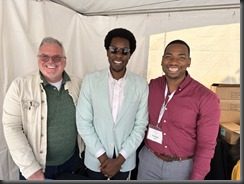"His Name is George Floyd" by Robert Samuels and Toluse Olorunnipa
September 30, 2023 6:47 Comments [0] Some men are more famous for their death than for their life. George Floyd is such a man.
Some men are more famous for their death than for their life. George Floyd is such a man.
Minneapolis policeman Derek Chauvin murdered Floyd in front of a crowd of eyewitnesses. Over a dozen cameras recorded the event, and millions more watched the video recordings of Floyd's last minutes of life. Chauvin held his knee on Floyd's neck for 9 minutes and 29 seconds until Floyd suffocated to death. On the recordings, we can hear Floyd begging for his life, repeatedly shouting, "I can't breathe." Many in the crowd pleaded with Chauvin to stop, but the officer's knee remained in place. George was 46 years old.
Washington Post reporters Robert Samuels and Toluse Olorunnipa told Floyd's story in their 2022 book "His Name Is George Floyd: One Man's Life and the Struggle for Racial Justice."
The book opens with three words that Floyd spoke often. Not "I can't breathe," but "I love you," which he said to friends and family in almost every conversation.
George Floyd grew up in a housing project of Houston's Third Ward - one of the poorest neighborhoods in the city. He dreamed of playing professional football. George was a good enough athlete to earn an athletic scholarship to a community college but not a good enough student to play at a major university. After leaving college, he returned to the Third Ward, where he could not find work. He turned to selling crack on street corners. Eventually, he began using the drug himself. He was arrested multiple times and sent to prison multiple times.
Floyd's life was far from perfect, but supporters and strangers have elevated him as a martyr to unchecked police violence. Derek Chauvin had a history of excessive violence, but he was seldom disciplined. The Minneapolis Police Department released a statement following Floyd's death that was absurdly far from the truth. His death sparked nationwide protests and public debates and prompted national legislation designed to hold police more accountable.
"His name" does an excellent job of humanizing a man who has become a symbol.
It explores his life, upbringing, and the events that sometimes led him to make poor decisions. Samuels and Olorunnipa even explore his family history. George's great-grandfather was a former slave who worked after the Civil War to own 500 acres but was cheated out of almost everything he owned.
The authors interviewed Floyd's friends, family, neighbors, and teachers to learn of Floyd's personality. George knew that his size (6'6" tall) often intimidated people, so he often went out of his way to project gentleness and friendliness when he met someone new.
The book's final section covers the police officers' trial, the verdict (A Minnesota court convicted Chauvin of murder and three other policemen of lesser charges,) and the aftermath. After seeing the videos, many people took to the streets across the country to protest, and politicians were inspired to pass new legislation.
George Floyd's story is not important because it is unique. It is important because it is not unique. Floyd is one of countless black men growing up in the ghettos of America, confronted with poverty, violence, and systemic racism. Politicians in both parties passed strong anti-crime legislation that disproportionately affected people of color. Texas tried solving its drug problem by focusing on harsh punishments rather than on treatment. Police routinely targeted the black neighborhood where Floyd grew up, looking for minor drug deals. Many of Floyd's friends died from drugs or the violence of the streets. Lacking adequate legal representation, Floyd accepted every plea bargain, fearing that a trial would result in a far worse punishment. His criminal record made it even more difficult to find permanent employment. Floyd spent the last three years of his life in Minneapolis, moving there to get a fresh start. However, the death of his roommate triggered a relapse into drug use.
Although he hoped to make his mark on the world with his life, George ultimately changed the world with his death. " His Name Is George Floyd" helps us understand George’s life, death, and ourselves.